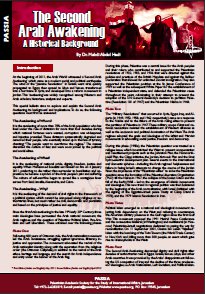The Second Arab Awakening A Historical Background
Overview
At the beginning of 2011, the Arab World witnessed a ‘Second Arab Awakening’ which came as a modern social and political earthquake. The wind of the “Jasmine Revolution” in Tunisia went viral, quickly propagated to Egypt, then spread to Libya and Yemen, transformed into a hurricane in Syria, and developed into a reform movement in Jordan. This ‘awakening’was widely recognized among Western and Arab scholars, historians, analysts and experts. This special bulletin aims to explore and explain the Second Arab Awakening, its background and implications. To do so, the following questions must first be answered:
The Awakening of Whom?
It is the awakening of more than 70% of the Arab population who has lived under the rule of dictators for more than four decades, during which national fortunes were wasted, corruption was widespread, and injustice prevailed. These dictators systematically degraded and censored their people, who eventually stood up in the face of tyranny chanting: “The people want to overthrow the regime.” The masses discarded the culture of fear, and were soon joined by the political and social elites.
The Awakening of What?
It is the awakening of national pride, dignity, freedom, justice and equality. When Mohammed Bouazizi set himself on fire on 4 January 2011, preferring to die rather than surrender to humiliation and oppression, he became a symbol of the Arab people’s pain and suffering. The culture of self-sacrifice began to spread like a contagious fever across Port Said, Ismailia, Alexandria, and Cairo.
The Awakening… Why?
It is the awakening of the demand of civil rights in the framework of a political system which cannot be composed along religious or authoritarian lines, but must rather be civil, democratic and pluralistic, and based on the principles of justice and equality. Since the first Arab awakening in the late 19th/early 20th Century, three main ideologies have permeated the Arab national movement, the Arab regimes, and the question of Palestine: Political Islam, Pan-Arabism and Left Liberalism. These unfolded over the following phases.
Phase One:
Following 400 years of Ottoman rule, the Arab nationalist movement led the Arab renaissance, struggling against ignorance, illiteracy, injustice and oppression. The movement advocated the revival of the Arab nationalist identity along with the separation from the religious order (the Ottoman Caliphate), in addition to the revival of the Arab ethos, heritage and language, and the search for Arab independence and unity under the banner of the Arab flag. During this phase, Palestine was a central issue for the Arab peoples and their rulers, who contributed to and supported the Palestinian revolutions of 1922, 1933, and 1936 that were directed against the policies and practices of the British Mandate and against the Balfour Declaration that allowed for unlimited Zionist immigration. They also supported the Palestinian position at the St. James Conference of 1939 as well as the subsequent White Paper for the establishment of a Palestinian independent state, and defended the Palestinian cause throughout the years culminating in their attempt to prevent the adoption of the UN General Assembly’s decision to partition Palestine (Resolution 181 of 1947) and the Palestinian Nakba in 1948.
Phase Two:
The “Military Revolutions” that occurred in Syria, Egypt, Iraq, and Algeria (in 1949, 1952, 1958, and 1962 respectively) came as a response to the Nakba and to the failure of the Arab ruling elites to prevent the partition of Palestine in 1947. These military coups d’état and national revolutions resisted the establishment of Western alliances as well as the economic and political domination of the West. The Arab regimes adopted the goals and ideologies of the leftist and Marxist movements in advocating social justice, freedom and democracy. During this phase (1950s), the Palestinian question was treated as a refugee issue, which incentivized the West to present compensation and resettlement projects such as the Johnston Plan, the Hammarskjoeld Plan, the Clapp initiative, the Jordan-Yarmouk Plan and the Sinai hydro-electric development plan. Several events in the international and domestic spheres – including the Arab regimes’ helplessness and failure in facing Israel’s attempts to change the course of the Jordan River, the impotence of the “Palestinian elites” to solve the Palestinian question since the formation of the Palestine Liberation Organization (PLO) till the Naksa in 1967, the collapse of the Soviet Union and the fall of the Berlin Wall – led to the emergence of Islamic movements and ideologies. This new trend in regional politics was then bolstered by the beginning of the Arab normalization with Israel (initiated with the signing of the Egyptian-Israeli peace Treaty at Camp David in 1978), and the 1979 Islamic Revolution in Iran.
Phase Three:
Political Islam emerged as a national and ideological movement rejecting Arab dependency on the West and refusing to countenance the American military presence in the Gulf region since the first Gulf War. This movement opposed the 1991 Madrid Peace Conference and the consecutive bilateral (in Washington) and multilateral (in Moscow) Palestinian-Israeli negotiations dedicated to paving the way for reconciliation. On 11 September 2001, Osama bin Laden “hijacked” Islam with the bombing of the Twin Towers (the World Trade Center) in New York and killing more than 300 people, an event which gave rise to Islamophobia in the West.
Phase Four:
The Second Arab Awakening demanded dignity and civil rights after decades of authoritarian rule in Egypt, Tunisia, Yemen, Libya, and other Arab countries. It was provoked by the Arabs’ disappointment following the US occupation of Iraq and the decline of the three predecessor ideologies, i.e. Arab Nationalism, Left Socialism, and Political Islam.

